|
| |
| New Visions of Computing |
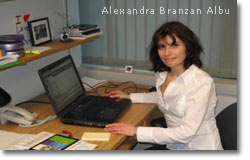 In the spring of 2007, ten high school girls were shown a different side of engineering. They attended the IMAGERIA workshop, which opened their eyes to image processing and artificial intelligence. The main idea of the IMAGERIA workshop was to attract a “different crowd”. The workshop involved computing applications to digital photography, entertainment and health care – interdisciplinary topics that would appeal to a wider group of students. In the spring of 2007, ten high school girls were shown a different side of engineering. They attended the IMAGERIA workshop, which opened their eyes to image processing and artificial intelligence. The main idea of the IMAGERIA workshop was to attract a “different crowd”. The workshop involved computing applications to digital photography, entertainment and health care – interdisciplinary topics that would appeal to a wider group of students.
In the IMAGERIA workshop, the girls were introduced to elementary image processing techniques. They examined the basic algorithms and were given the opportunity to work on photos of their choice. For example, one of the modules involved digitally stitching together panoramic images. The girls were able to choose from a bank of images, or take their own image with a digital camera. They explored not only the technical elements, but the artistic ones, as they selected image content, perspective, lighting, etc.
At the helm of the workshop was UVic’s Dr. Alexandra Branzan Albu. Alexandra completed her engineering degree in Romania. In the process, she became inspired by the idea of using medical image analysis to contribute to making people healthier. During her PhD in electronic engineering, which she completed at the Polytechnic University of Bucharest, she studied pattern recognition in medical imaging. Today, she works on several different projects to do with improving human health, including using computers to study the gait of elderly people in order to detect signs that they may experience a fall.
She says that the cultural attitude towards computer engineering in Romania is quite different than it is in Canada, and she was surprised how few women she met in the field when she moved here. She realizes now that she was a little bit “spoiled” growing up by having many female peers in her area of interest. Now, when she goes to conferences, she is one of the few women and this makes it more difficult for her to network.
To help address this problem, Alexandra has taken an interest in encouraging young Canadian girls to learn more about computer science and its applications. She investigates “new paths into recruiting female students in engineering.” The IMAGERIA workshop was born out of a desire to bring the concept of computer vision to high school students, and to demonstrate that engineering at UVic features a collaborative, dynamic learning environment. Furthermore, the workshop showed how engineering reached into the fields of art and health care.
She is helping establish a new vision of computing as something that is engaging, creative, and with far-reaching impacts and the ability to improve lives. And this new vision of computing is attracting attention! One of the important effects of the workshop was to start girls thinking about the many different careers available for them involving computer science, and digital imaging in particular. As one participant wrote, “The workshop was a fun and educational experience which will undoubtedly help many of girls in the future careers such as Radiology and Video Surveillance.” These are just two of the many options opened in the minds of these girls by Alexandra and her workshop.
|
|
|
| Dancing Equations in Uppsala |
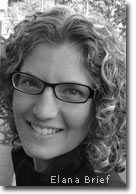 How did it come to pass that I found myself dancing physics equations with gender researchers and physicists in a small town in Sweden? How did it come to pass that I found myself dancing physics equations with gender researchers and physicists in a small town in Sweden?
Last spring I received an invitation through the Society for Canadian Women in Science and Technology (SCWIST) to “Crossing perspectives on Gender and Physics”, a conference bringing together the Nordic Women in Physics (NorWiP) and the Workshop on Physics and Gender (GenDADA) at the Centre for Gender Research at Uppsala University, Sweden. I couldn’t believe that there was a conference bringing together my two academic loves: physics and gender. I was able to attend the conference thanks to the Jade Project and the travel support they offered.
In the literature for the conference, the organizers called for abstracts that would investigate how gender may influence pedagogy, hiring and promotion in physics. At a deeper level, they also wanted participants to consider about how questions in physics may be gendered: do women ask different scientific questions than men?
I submitted two abstracts for the conference, and both were accepted for talks: “Dancing Equations: the embodiment of physics” and “Hard Science with a Soft Heart: does the involvement of women delegitimize a subfield?”
As I prepared my presentations, I was suddenly stumped by how I might give talks that were meaningful to both physicists and gender researchers? For “Dancing Equations” I constructed a talk around how I have taught engineering physics undergraduate students about light polarization through dance. To prepare for delivering the talk, I met with physicists at SFU Burnaby and gender researchers at SFU Harbour Centre. In those practice talks, I had merely demonstrated the dance steps. All of my colleagues asked whether I would get the conference participants to dance? Once I arrived in Sweden, I thought, “I’m so far from Vancouver – what have I got to lose?!” I had the conference attendees dance electric field equations. The mix of physicists and gender researchers was just right that everyone got the steps (see photo).
The other talk on the potential devaluation of women in science was harder to prepare for. I found I had to oversimplify both the gender and the physics concepts. In an attempt to bridge two disciplines, I started to recognize how far they were from each other. How would I introduce concepts of gender to physicists who have never been trained in the social sciences? How could I speak about subfields of physics to established gender researchers who last encountered physics in high school? Yet the process of trying to connect physics and gender demonstrated to me that to advance women in physics we require the insights of gender researchers.
Gender is a socio-cultural construct. It shapes how we understand and experience masculinity and femininity and how value is assigned to certain behaviours and not to others. Until now I had been wondering how to prepare women better for succeeding in physics and other male-dominated fields. I am changing my mind about that approach: I am now more interested in assessing how the fields themselves may have to transform. It is by talking (and dancing!) with gender researchers that we will determine meaningful and successful ways to promote girls and women in science and engineering.
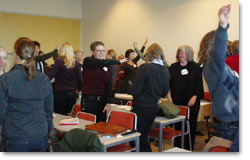
Physicists and gender researchers dancing equations during my talk. They were dancing the following equation:

(Photo credit to Helene Götschel.)
For more about the conference, please read Elana’s article in the January 2009 UBC-V Physics Newsletter.
Elana Brief, PhD Physics (UBC, 2000)
Research Director, Women’s Health Research Network
President, Society for Canadian Women in Science and Technology
Research Associate, Physics, University of British Columbia
|
|
|
| Enter the Jade Brigade |
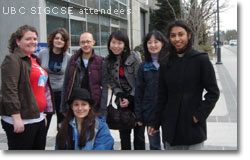 This March, the bold Jade Brigade jumped in a van and headed south! Ten students from UBC were sponsored by the Jade Project to attend an event called the Technical Symposium on Computer Science Education (SIGSCE 2008) at the Oregon Convention Center in Portland, Oregon. This March, the bold Jade Brigade jumped in a van and headed south! Ten students from UBC were sponsored by the Jade Project to attend an event called the Technical Symposium on Computer Science Education (SIGSCE 2008) at the Oregon Convention Center in Portland, Oregon.
Group shot of the Jade Brigade. From left to right of top row: Jill Dicker, Jessica Dawson, Chrissie Kwan, Danielle Kwek, Jenny Qian, Pooja Viswanathan, and in front Elizabeth Patitsas. (Not pictured are Rachel Teo, a late addition, Bhav Khaira, and Leah Russ.)
The conference offered technical sessions on computer science education, including talks, panels, posters, workshops and break-out sessions. Organizers hoped to create a place where educators and students at all levels of instruction could network with each other, discuss common challenges, and share innovative new techniques. This year, the focus of the symposium was the development of a “more complete, more diverse, and more successful population of future computer science professionals” (to find out more about this year’s symposium, visit the website at: http://www.cs.duke.edu/ sigcse08/). Therefore, the theme of this year’s symposium was “Diversity through Accessibility”.
As one of the students, Jenny, recounts: “There was plenty of discussion of attracting underrepresented groups to CS, including women”. There are different kinds of accessibility issues that exclude individuals from computer science. Sometimes those accessibility issues are physical.
For example, the girls each provided comments on some of the sessions they attended and the individuals they met. One student, Jessica, met with a conference chair, J. D. Dougherty. Of Dougherty, Jessica wrote that his work developing computers that defy the conventional “position” of “sitting on a chair, hands on a keyboard, staring at a screen” was of particular interest. This was a way to broaden computer accessibility to many different individuals. Different configurations allow participation by physically disabled individuals, as well as those who simply do not feel as comfortable or as creative working in front of a conventional computer.
However, there are also other accessibility issues beyond the physical. Many groups feel excluded and discouraged from studying computer science. Several sessions at the symposium shared new techniques in computer science with the potential to encourage more students to thrive.
One of these techniques is collaborative learning. Several of the workshops selected by Jenny discussed this new collaborative approach to computer science education. The usefulness of this technique was reinforced by keynote speaker Marissa Mayer, VP of Google's Search Products and User Experience Division, who spoke about the necessity of team interaction in the programming world.
Another session discussed the educational applications of pair-programming. Pair-programming is when two programmers share the same keyboard and work on a project together.
This technique started in industry, but as presenters Braught, Eby and Wahls proposed, using this approach in computer science classes can have educational benefits. According to Jenny, the presenters found that “1) Students with lower scores improved statistically significantly in individual programming skills through pair-programming; 2) All the students, regardless of previous academic achievements, were more likely to complete the CS1 course successfully via pair-programming.”
In their experiment, having students pair-program led to better programs. It also increased motivation and gave programmers more confidence. A lack of motivation and confidence is often responsible for girls’ negative experiences in computer science.
Curiously, Jenny reports, the presenters recommended that the two students working together on pair-programming have a similar skill level. That way, neither of the students did more of the work and both students learned a lot from the other.
According to student Danielle, SIGCSE was an "eye-opener"; she says that it was a "super-tiring 4 days...but enriching and inspiring nonetheless"! The ten Jade Brigadiers all learned a lot about computer science education and were inspired to keep looking for ways to increase accessibility to this education. They brought their reports back to the UBC Computer Science Department where the new ideas they discovered are being explored by instructors and other faculty members.
|
|
| Hiromi Matsui |
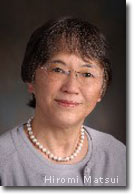 Hiromi Matsui has been passionate about working towards equality for a long time. She was born in an internment camp for Japanese-Canadians in Sandon, BC. Even though both her parents were Canadian citizens who were born in Canada, they were forced by the government to relocate from Vancouver to the camp. Since then, the Canadian government has acknowledged its wrongdoing and has apologized. This has heightened her interest in social justice for under-represented groups which has led to another cause, spending decades advocating for equality for women. Hiromi Matsui has been passionate about working towards equality for a long time. She was born in an internment camp for Japanese-Canadians in Sandon, BC. Even though both her parents were Canadian citizens who were born in Canada, they were forced by the government to relocate from Vancouver to the camp. Since then, the Canadian government has acknowledged its wrongdoing and has apologized. This has heightened her interest in social justice for under-represented groups which has led to another cause, spending decades advocating for equality for women.
Hiromi received her Masters degree from the London School of Economics. Even at this early stage, she was already excited about important economic benefits of women in the workforce. Her thesis was entitled, “Working Women in France, Canada, Japan, and the US”.
Since graduation, she has held many positions that have expanded opportunities for women – I can’t even begin to name them all! For this article, I will write about just a few of her accomplishments. For example she was the Engineering Science Internship Coordinator at SFU. In this position, she interacted with employers and discussed the importance of providing an “even playing field” for female employees. Today, Hiromi is the Faculty of Applied Science Director of Diversity and Recruitment at SFU and her enthusiasm for the cause has grown.
Hiromi believes in the strong business case for the increased participation of women in science, engineering, trades and technology. At its crux, “diversity in the labour force improves economic performance”, says Hiromi. As part of the WinSETT Initiative, she worked towards policy changes to improve the “recruitment, retention and advancement of women in science, engineering, trades and technology.”
With the current high-tech labour shortage, encouraging women to develop these skills and pursue these careers can have crucial economic benefits for the province and the country. Because of her important insights, she was invited to join a panel for the Applied Science Technologists & Technicians of British Columbia that discussed how to deal with the technology skills shortage in BC.
In order to spark an interest in science, engineering and technology, Hiromi participates in events which encourage women of all ages and levels of education. For example, to foster an early interest in computer science for young girls, she volunteered with the ChicTech project. For more on the ChicTech project, click here.
Among some of the other highlights of her career are serving as president of SCWIST – Society for Canadian Women in Science and Technology and as president of CCWESTT – Canadian Coalition of Women in Engineering, Science, Trades and Technology. For more on CCWESTT and its latest conference, see the Summer 2008 newsletter.
In 2007, in honour of her distinguished career, she was recognized as the YWCA Woman of Distinction award in Technology, Science & Industry.
|
|
| What I Learned from Grace Hopper |
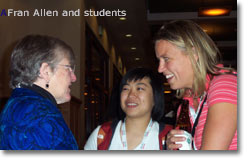 For the very first Jade Project Newsletter I wrote, I travelled out to SFU to meet with a woman named Janice Regan about her involvement with the ChicTech project (link). It was my first in-person interview, and I was very nervous. Janice put me at ease, and began answering my questions about the inspiration for the ChicTech event. I jotted down my notes, and went home and typed them up, proud as can be. Then I sat down with Anne Condon to look over my draft. For the very first Jade Project Newsletter I wrote, I travelled out to SFU to meet with a woman named Janice Regan about her involvement with the ChicTech project (link). It was my first in-person interview, and I was very nervous. Janice put me at ease, and began answering my questions about the inspiration for the ChicTech event. I jotted down my notes, and went home and typed them up, proud as can be. Then I sat down with Anne Condon to look over my draft.
She read the following sentence, and chuckled uproariously: “As an active member of the outreach committee, Janice was thrilled when colleague Grace Hopper returned from a conference at the University of Illinois with a brilliant idea.”
Anne pointed out that that would be an incredible feat, since Grace Hopper was a US Naval Officer who died in 1992. Actually, “Grace Hopper” had been the name of the conference – short for the Grace Hopper Celebration of Women in Computing, a celebration designed to “bring the research and career interests of women in computing to the forefront”. Because Grace Hopper was such a monumental figure in computer science and also such a pioneer for women in computing, my error was entertaining. The incident was quite embarrassing, but it did help me learn a lot as a journalist – and as a female scientist.
Since then, my interviewing skills have improved (I hope so, at least). And I’ve also gotten a chance to learn more about Grace Hopper. She is firstly recognized for her contributions to the field of computing, such as developing the first compiler and working on the first fully-automatic electronic calculator called the Harvard Mark I. She is also recognized for being a pioneer for females in the field, advancing to a high rank in the Navy, which was overwhelmingly male at the time. As conference participant Petcharat recounted, after listening to two young, female, U.S. Navy officers, the “USS Hopper was the only warship named after a pioneering computer scientist”.
This year, I had the chance to get to know what goes on at the Grace Hopper conference. The Jade project sponsored 6 students to attend the conference, which took place at the Keystone Resort in Colorado. The conference spanned four full days and was described by attendee Samantha as an “invaluable experience”.
Networking was a key goal of the conference. For example, Samantha wrote about many influential encounters she had, such as with a NASA employee and a Master’s student aspiring to work with NASA. Samantha says that “not only were we able to get lots of advice from Yvonne, but we also got to know each other and found that we shared a lot of common interests, including watching science fiction series. We plan to keep in touch”.
The girls also were given a morale boost. One thing that struck Petcharat was that many women in top computing positions talked about continuing uncertainty in their own abilities. She says that it was “very, very inspiring to know that even the Dean of Science of Princeton who used to be very diffident could become more confident and successful in her career.”
What were women to do in the face of these doubts? Just do your best, the panelists said. One suggestion by panelist Tessa Lau was picking up a book called "Feel your fears, but do it anyway". Petcharat really liked the book title; “I think I'll let that be my motto from now on”, she says. In fact, all of the girls made comments about the strong sense of community they felt being surrounded by women situated throughout the technical and academic world.
An added bonus was a place where an exchange of ideas occurred about ways to interest younger girls in learning about computer science as well. For example, Petcharat is planning on volunteering with GirlSmarts (also a link). She attended a presentation about the Artemis Project, which was a “project that was run by a group of undergraduate female students at Brown University to encourage grade 8-9 female students to consider career in computer science and engineering”. She learned about different ways to engage young students in computer science, as well as new techniques for teaching Excel, Photoshop, and programming.
The conference also featured technical talks, designed to spark interest in new areas of computing research. For example, Samantha noted her enjoyment of Anna Karlin's introduction to game theory, saying that the talk was “captivating and provided strong motivation for studying problems in that area.”
Finally, there was a bit of added specialness for the girls who traveled to Grace Hopper from UBC. The participants were all thrilled to see Anne Condon, on stage in front of over 1400 people, welcoming everyone to the conference. To see the accomplished bioinformatician, Associate Dean, NSERC Chair for Women in Science and Engineering for B.C. and the Yukon, mentor and friend was an emotional experience. The girls saw that not only can women succeed, but they can use their success to nurture, educate and inspire others. And that is an experience that none will soon forget.
|
|
|


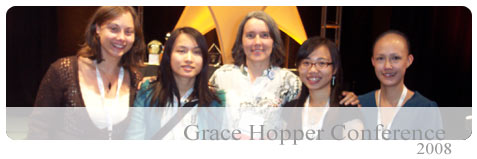
 In the spring of 2007, ten high school girls were shown a different side of engineering. They attended the IMAGERIA workshop, which opened their eyes to image processing and artificial intelligence. The main idea of the IMAGERIA workshop was to attract a “different crowd”. The workshop involved computing applications to digital photography, entertainment and health care – interdisciplinary topics that would appeal to a wider group of students.
In the spring of 2007, ten high school girls were shown a different side of engineering. They attended the IMAGERIA workshop, which opened their eyes to image processing and artificial intelligence. The main idea of the IMAGERIA workshop was to attract a “different crowd”. The workshop involved computing applications to digital photography, entertainment and health care – interdisciplinary topics that would appeal to a wider group of students.  How did it come to pass that I found myself dancing physics equations with gender researchers and physicists in a small town in Sweden?
How did it come to pass that I found myself dancing physics equations with gender researchers and physicists in a small town in Sweden?
 This March, the bold Jade Brigade jumped in a van and headed south! Ten students from UBC were sponsored by the Jade Project to attend an event called the Technical Symposium on Computer Science Education (SIGSCE 2008) at the Oregon Convention Center in Portland, Oregon.
This March, the bold Jade Brigade jumped in a van and headed south! Ten students from UBC were sponsored by the Jade Project to attend an event called the Technical Symposium on Computer Science Education (SIGSCE 2008) at the Oregon Convention Center in Portland, Oregon.  Hiromi Matsui has been passionate about working towards equality for a long time. She was born in an internment camp for Japanese-Canadians in Sandon, BC. Even though both her parents were Canadian citizens who were born in Canada, they were forced by the government to relocate from Vancouver to the camp. Since then, the Canadian government has acknowledged its wrongdoing and has apologized. This has heightened her interest in social justice for under-represented groups which has led to another cause, spending decades advocating for equality for women.
Hiromi Matsui has been passionate about working towards equality for a long time. She was born in an internment camp for Japanese-Canadians in Sandon, BC. Even though both her parents were Canadian citizens who were born in Canada, they were forced by the government to relocate from Vancouver to the camp. Since then, the Canadian government has acknowledged its wrongdoing and has apologized. This has heightened her interest in social justice for under-represented groups which has led to another cause, spending decades advocating for equality for women. For the very first Jade Project Newsletter I wrote, I travelled out to SFU to meet with a woman named Janice Regan about her involvement with the ChicTech project (link). It was my first in-person interview, and I was very nervous. Janice put me at ease, and began answering my questions about the inspiration for the ChicTech event. I jotted down my notes, and went home and typed them up, proud as can be. Then I sat down with Anne Condon to look over my draft.
For the very first Jade Project Newsletter I wrote, I travelled out to SFU to meet with a woman named Janice Regan about her involvement with the ChicTech project (link). It was my first in-person interview, and I was very nervous. Janice put me at ease, and began answering my questions about the inspiration for the ChicTech event. I jotted down my notes, and went home and typed them up, proud as can be. Then I sat down with Anne Condon to look over my draft.